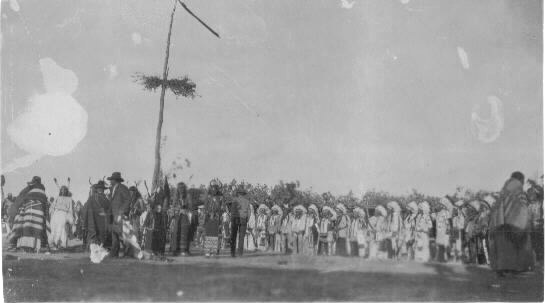


|
Not far away was the camp of Bear Dog, a brother of
the famous Hollow Horn Bear—last of that family of chiefs. He possessed
the original Peace medal presented to his grandfather by President
George Washington; it bore the date 1789 and was worn by the three
succeeding generations of chiefs, and lastly by his brother, who gave
it to him at his death, many years ago. Near by was met Good Face, a survivor of the Custer fight, who had been with Buffalo Bill in his tour of Europe, and of whom the Farm superintendent said, "He is the finest man on the Reservation." Frank Goings, the scout, Jim Grass, Kills-Close-to-the-Lodge, White-Rabbit and Nancy Sitting Bull, were encountered while on a walk through the Sioux district villages. In the midst of the solemnities of the dance rituals, a political candidate intruded with his retinue of office-holders and moving picture men. The performers were jostled by the rude camera-carriers and news-reel fiends, who, in the mad struggle to obtain records of this notable event, climbed upon the roof of their frail "wickiup" and crushed the timbers. They pawed over those who sat in its shade regardless of manners or results. The candidate was required to have his picture taken, with the chief in regalia, in the act of grasping his hand in welcome, for propaganda in the elections then coming on. The chief had to be urged, but finally yielded, and the photo was made. It appeared in the Sunday supplements throughout the eastern cities, where it is presumed it had its expected favorable effect in the ballot-box, but it had a decidedly adverse result when the Indian ballots were counted in the west. With the unwelcome interruption, the performers quit abruptly and refused to complete the afternoon ceremonies, whereupon the Winnebagoes took control of the arena and started a war-dance in which other tribes joined. As twilight came on all the various tribes joined in the excitement, until the multitudes covered the vacant ground all around. The larger the crowd became the faster they danced and the louder the yelping war cries resounded over the bordering hills. Looking on from a higher altitude this moving mass of humanity offered a unique spectacle—one never seen before, and most likely never to be seen again. It was the biggest war- dance ever held. A ranchman who was looking on remarked that he was accustomed to big things in the big western country, but the scene before him was, in its dimension and import, astounding. It was with a feeling of sadness and humiliation that we entered and took part in the ceremony with the old chiefs for the last sun dance of the Sioux, knowing as all did that it would be the farewell between friends—almost half a century of friendly intercourse and mutual understanding now to end forever. A last ceremonial smoke with the old warriors in the Council tepee, hearty handshake to each, and we were off for a drive across the Indian's home lands, west to the border. We wanted to see how they now lived as compared with the long ago. From the hill-top three miles out a backward glance revealed the breaking up of the grand conclave we had participated in; it was the clearing of the stage after the fall of the curtain on a notable national tragedy; it was as if there had been performed the last sad rites at the grave of stricken brothers. It was the end of the old-time Indian days. |
|
|
|
|
|
|
||
| previous page | table of contents | next page |
|
|
||